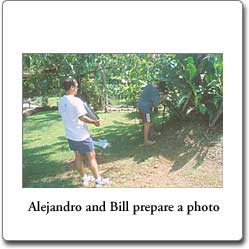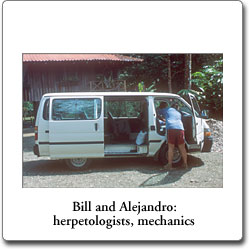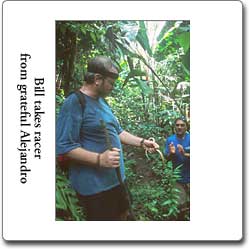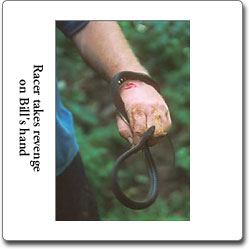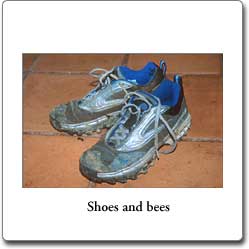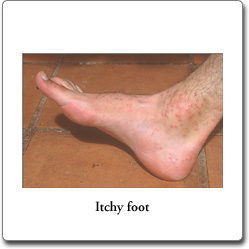| |||
|
|||
|
Click any image to see a larger version. |
|||
|
The Adventures of Bill and Alejandro
I've never spent several days with professional herpetologists before, so I can't really tell you what it's like to hang out with professional herpetologists in general. But I can tell you what it's like to hang out with Bill Lamar and Alejandro Solorzano: it's educational, and it's constantly entertaining. Bill has done everything you might expect a professional herpetologist would do. He's spent years in the field. He's written books for experts. He's written books for laypeople. He's taught courses at universities. He's been the star of documentary films about wild reptiles. He has published top-notch photos. He's written stories of his adventures. He's met every herpetologist you've ever heard of, and worked with many of them. And he's always willing to share his knowledge, stories, and well-formed opinions. Alejandro was a great herping companion also, though we were all hampered by our inability to speak Spanish. He speaks English carefully and clearly, but is clearly much more comfortable in Spanish. It's a bit of an unfair advantage for Bill, who got to tell us embarrassing Alejandro stories at every opportunity, whereas Alejandro could probably communicate his embarrassing Bill stories very well only in Spanish. Or maybe he was just too polite to share them. Bill regaled us with tales of life in the tropics, other herpetologists, and the truth about those documentary shows you see on the Discovery Channel. It's fairly certain that you won't be seeing "The Adventures of Bill and Alejandro" as a weekly feature a la "The Crocodile Hunter". I think Bill would sooner be bitten by every venomous snake in the forest, and a scorpion or two also. Both of them knew the herps of the area extremely well. One big advantage to travelling with herpetologists is that they can identify the species you run across confidently. Usually after one of my trips to foreign lands it takes me days or even weeks of searching the web, studying my herp book collection, and sometimes corresponding with various experts before I can identify most of the species I've seen with any certainty. But with Bill and Alejandro around, I updated the list of species we saw every day, and it was complete before I left Costa Rica. We were in good hands with Bill and Alejandro. We knew they would make good decisions and take care of whatever needed to be taken care of. One day we were ready to hop into the van, but turning the key had no effect. The van was dead. Maria and Vicki wandered off to the bar to have a soda, and I wandered off into the foliage to look for lizards, but Bill and Alejandro pulled parts out, twiddled with other parts, and put things back together such that the van worked again in about ten minutes. Not bad for a vehicle they had rented for the first time a couple of days earlier. |
|||
|
|||
| One difference between our two herpetologist guides was that Alejandro didn't like being bitten by snakes. He pinned a Salmon-bellied Racer, Mastigodryas melanomus, on the trail one morning. The (non-venomous) snake was not happy about this and was striking repeatedly, trying to convince Alejandro to let go. Alejandro was hesitant about grabbing the snake's head, so Bill just picked it up and laughed as it bit him on the wrist and fingers. Bill assured us that the oozing blood didn't hurt at all, and wouldn't leave a scar. We believed him. Mostly. | |||
|
|||
|
Footnotes
I brought fairly new, fairly expensive hiking shoes to the forest. By contrast, Bill used some ill-fitting tractionless pair of Keds that an earlier traveler had left behind. After a few days, you couldn't tell which of the two pairs had started the trip clean. When you come on your next GreenTracks trip (you are coming, aren't you?), keep this in mind. After each morning mud bath, I'd leave my shoes on the tile porch in front of my room. For some reason, this thrilled the local bee population. Perhaps there were yummy minerals in the forest clay that the bees couldn't find around the lodge. You can see in this next picture that not only are there bees on and in the shoes, there are even bees rolling around in some sort of bee scrum between them. |
|||
|
|||
| One final minor cautionary note. When someone tells you "I hardly notice the mosquitos in the forest; they're no worse than back home", keep in mind that mosquitos like some people better than others. In general, I think mosquitos grow bored with the same old skin, and are excited at the prospects of fresh new-to-the-forest skin. In particular, mosquitos like me. I chose not to use repellent (I don't like the smell and feel and idea of it), and little bitty silent mosquitos enjoyed dining on my feet in the afternoons when we'd photograph our detained animals. By the end of the week my feet were an impressive sight. As far as I can tell, I remain tropical-disease-free. | |||
|
|||
|
The bottom line is: I saw far more species of reptiles and amphibians on this
trip than on any other trip I've ever taken anywhere. I also learned a ton
about photography and about herpetology and herpetologists. I know of no better way to both find
herps and learn more about them than to visit Latin America with
GreenTracks. I certainly hope
to travel with them again someday.
Here is a complete list of the herp species we encountered.
John Sullivan |
